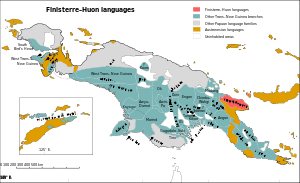Finisterre–Huon languages
| Finisterre–Huon | |
|---|---|
| Geographic distribution | New Guinea |
| Linguistic classification |
Trans–New Guinea
|
| Subdivisions | |
| Glottolog | fini1244[1] |
 Map: The Finisterre–Huon languages of New Guinea
The Finisterre–Huon languages
Other Trans–New Guinea languages
Other Papuan languages
Austronesian languages
Uninhabited | |
The Finisterre–Huon languages comprise the largest family within the Trans–New Guinea languages (TNG) in the classification of Malcolm Ross. They were part of the original TNG proposal, and William A. Foley considers their TNG identity to be established. The languages share verbs which are suppletive depending on the person and number of the object, strong morphological evidence that they are related.
Huon and Finisterre, and then the connection between them, were identified by Kenneth McElhanon (1967, 1970). When McElhanon compared notes with his colleague Clemens Voorhoeve, who was working on the languages of southern Irian Jaya, they developed the concept of Trans–New Guinea. Apart from the evidence which unites them, the Finisterre and Huon families are clearly valid language families in their own right, each consisting of several fairly-well defined branches. (See Finisterre languages and Huon languages.)
Ross reconstructs the pronouns as follows:
sg du pl 1 *na *na-t, *ni-t *na-n, *n-in 2 *ga *ja-ł, *ji-ł, *gi-ł *ja-n, *ji-n, *gi-n 3 *[y]a, *wa, *i *ya-ł, *i-ł *ya-n, *i-n
These are not all coherent: 3sg *ya and *i are found in Huon, for example, while 3sg *wa is found in Finisterre. In other cases, however, the multiple forms are found in both branches.
Footnotes
- ↑ Hammarström, Harald; Forkel, Robert; Haspelmath, Martin, eds. (2017). "Finisterre–Huon". Glottolog 3.0. Jena, Germany: Max Planck Institute for the Science of Human History.
References
- Ross, Malcolm (2005). "Pronouns as a preliminary diagnostic for grouping Papuan languages". In Andrew Pawley; Robert Attenborough; Robin Hide; Jack Golson. Papuan pasts: cultural, linguistic and biological histories of Papuan-speaking peoples. Canberra: Pacific Linguistics. pp. 15&ndash, 66. ISBN 0858835622. OCLC 67292782.